 |
|
| Home | Town | History | People | Events |
| Media | Schools | Government | Links | Back to Feud |
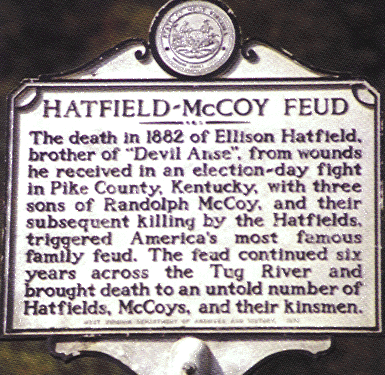 In
American history and folklore the Hatfields and the McCoys symbolize the
backwardness and violence most Americans associate with Appalachian mountain
culture. Yet an accurate retelling of this famous instance of family
conflict reveals a more complex story - - a story involving competition over
rich timer resources and the desire of eastern corporations and state government
to foster economic development in the region. The feud was more a
foreshadowing of the era of the bloody coal mine wars than it was the final gasp
of traditional mountain culture.
In
American history and folklore the Hatfields and the McCoys symbolize the
backwardness and violence most Americans associate with Appalachian mountain
culture. Yet an accurate retelling of this famous instance of family
conflict reveals a more complex story - - a story involving competition over
rich timer resources and the desire of eastern corporations and state government
to foster economic development in the region. The feud was more a
foreshadowing of the era of the bloody coal mine wars than it was the final gasp
of traditional mountain culture.
The first hint of animosity between the Hatfields and McCoys occurred in the fall of 1878 on the Kentucky side of the Tug Fork. This was a time when the Tug Valley was one of the most remote and isolated valleys in the United States; there were no railroads, no coal mines, and no villages or towns. When Randolph McCoy accused Floyd Hatfield of stealing his hog, it was a very serious offense; hogs were extremely valuable to the farming economy of the valley and court records indicate that any kind of theft was very rare. For the most part, an atmosphere of trust prevailed among neighbors up and down the hollows. But when Randolph McCoy took his complaint to the local judge and that judge took the trouble to assemble a jury evenly divided between Hatfields and McCoys it is obvious that trouble already existed between these two families.
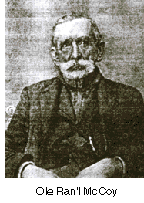
 Whatever
the specific grievances, it is significant that the McCoys attempted to resolve
them through the legal system, not with guns and violence as Appalachian
stereotypes would suggest. When the court ruled against Randolph McCoy he
accepted the verdict but bad feelings festered over the next four years,
especially when Devil Anse's son, Johnse, romanced and impregnated but did not
marry Randolph McCoy's daughter Roseanna. The peak of hostilities came
when three of Roseanna's brothers attacked and killed Ellison Hatfield on
election day in 1882. Because the Tug Fork of the Big Sandy River is the
boundary between Kentucky and West Virginia and and jurisdiction was unclear,
the legal system, for the first time in the feud, broke down. Devil Anse
retaliated for the killing of his brother by executing, without trial, the three
sons of Randolph McCoy near present day Matewan, West Virginia.
Whatever
the specific grievances, it is significant that the McCoys attempted to resolve
them through the legal system, not with guns and violence as Appalachian
stereotypes would suggest. When the court ruled against Randolph McCoy he
accepted the verdict but bad feelings festered over the next four years,
especially when Devil Anse's son, Johnse, romanced and impregnated but did not
marry Randolph McCoy's daughter Roseanna. The peak of hostilities came
when three of Roseanna's brothers attacked and killed Ellison Hatfield on
election day in 1882. Because the Tug Fork of the Big Sandy River is the
boundary between Kentucky and West Virginia and and jurisdiction was unclear,
the legal system, for the first time in the feud, broke down. Devil Anse
retaliated for the killing of his brother by executing, without trial, the three
sons of Randolph McCoy near present day Matewan, West Virginia.
For five years after this shocking incident, things were quiet in the Tug Valley. No newspaper anywhere reported the feud and most residents fervently wished to forget about it. But developments outside the Tug Valley mandated otherwise. The Norfolk and Western Railroad Company announced plans to build a line linking Virginia with the Ohio River to run right through the Tug Valley. This would allow the large scale exploitation of the high quality coal seams known to exist in the region. The Tug Valley was about to become the focus of the economic modernization and development which had bypassed it for so long; there were huge profits to be made in land, timber, and coal.
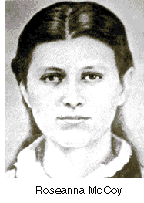 In
this new political and economic climate, the Hatfield-McCoy feud was revived by
a Pikeville lawyer named Perry Cline. Cline was a distant cousin of
Randolph McCoy who had grown up in the Tug Valley, a neighbor of Devil Anse
Hatfield. As a young man he had fought a protracted legal battle with
Devil Anse over five thousand acres of land along Grapevine Creek, West
Virginia. In and out of court settlement Cline had lost the five thousand
acres to Devil Anse, land that was now skyrocketing in value. In 1887
Cline used his influence with the leading citizens of Pikeville and the Governor
of Kentucky to have the five year old murder indictments against the Hatfields
reissued and to have an extradition process started to bring them to trial in
Kentucky. Not satisfied, however, with the slowness of the legal process,
Cline recruited "Bad" Frank Phillips who organized a posse, crossed
the Tug Fork into West Virginia and captured nine Hatfield supporters.
This entailed several quasi-military skirmishes along Grapevine Creek and an
attempt by the Hatfields to eliminate Randolph McCoy on January 1, 1888.
This action resulted in the death of two of Randolph McCoy's children and the
destruction of their home on Blackberry Fork, Kentucky, by fire.
In
this new political and economic climate, the Hatfield-McCoy feud was revived by
a Pikeville lawyer named Perry Cline. Cline was a distant cousin of
Randolph McCoy who had grown up in the Tug Valley, a neighbor of Devil Anse
Hatfield. As a young man he had fought a protracted legal battle with
Devil Anse over five thousand acres of land along Grapevine Creek, West
Virginia. In and out of court settlement Cline had lost the five thousand
acres to Devil Anse, land that was now skyrocketing in value. In 1887
Cline used his influence with the leading citizens of Pikeville and the Governor
of Kentucky to have the five year old murder indictments against the Hatfields
reissued and to have an extradition process started to bring them to trial in
Kentucky. Not satisfied, however, with the slowness of the legal process,
Cline recruited "Bad" Frank Phillips who organized a posse, crossed
the Tug Fork into West Virginia and captured nine Hatfield supporters.
This entailed several quasi-military skirmishes along Grapevine Creek and an
attempt by the Hatfields to eliminate Randolph McCoy on January 1, 1888.
This action resulted in the death of two of Randolph McCoy's children and the
destruction of their home on Blackberry Fork, Kentucky, by fire.
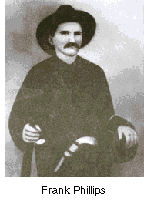
By 1892. the railroad through the Tug Valley was completed and coal began to be shipped out. The towns of Williamson and Matewan sprang up along the West Virginia bank of the Tug Fork. The feud was over. (It had lasted 12 years and cost 12 lives.) But the violence that marked the beginning of economic modernization was to continue and even intensify as mountain farmers became coal miners who clashed repeatedly with owners in a conflict which culminated in the bloody coal mine wars of the 1920s.
Altina L. Waller is an Associate Professor
of History at the University of New York, Plattsburgh, and is author of the
recent publication, FEUD: Hatfields, McCoys, And Social Changes In Appalachia
1860-1900.
| Home | Town | History | People | Events |
| Media | Schools | Government | Links | Back to Feud |
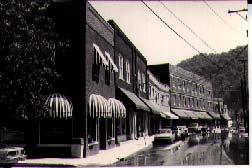
Back to matewan.com
matewan@a-aautoparts.com